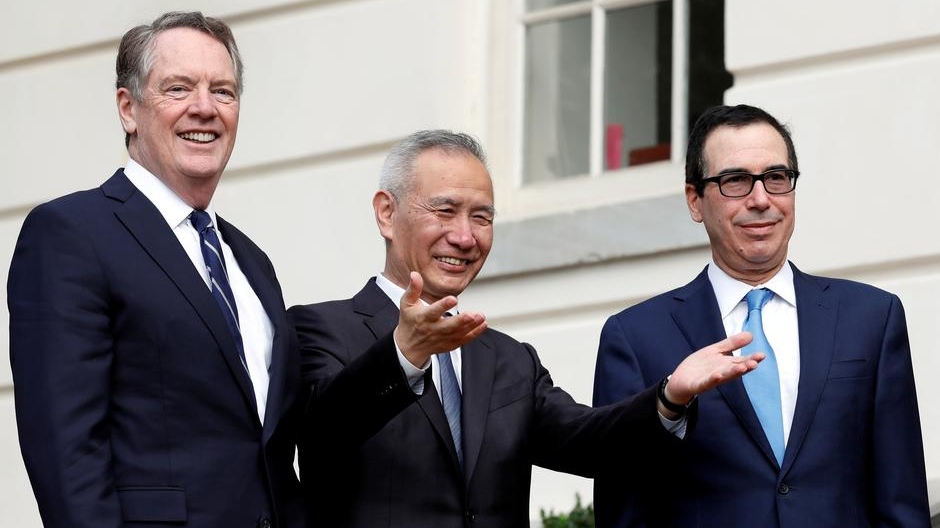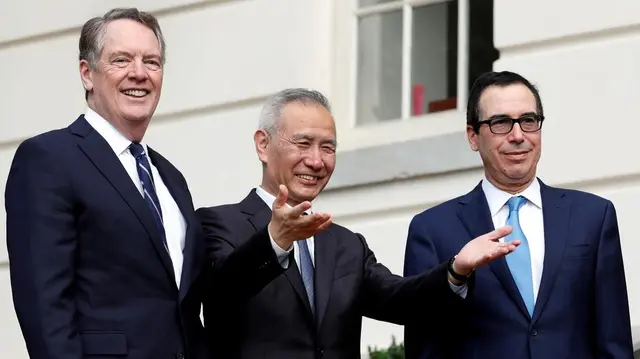
China's Vice Premier Liu He gestures to the media between U.S. Trade Representative Robert Lighthizer (L) and Treasury Secretary Steve Mnuchin before the two countries' trade negotiations in Washington, DC, U.S., October 10, 2019. /Reuters
Five months have gone by since the signing of the China-U.S. phase-one economic and trade agreement and there are concerns on both parts about its implementation.
On Thursday, Chinese Vice Premier Liu He, chief of the Chinese side on the China-U.S. comprehensive economic dialogue, called at the Lujiazui Forum in Shanghai for cooperation between China and the U.S..
The two countries should create conditions and atmosphere, and eliminate interference to jointly implement the phase-one economic and trade agreement, Liu underscored.
U.S. Trade Representative Robert Lighthizer defended the trade deal that President DonaldTrump has soured on at a Senate Finance Committee hearing on Trump's 2020 Trade Policy Agenda. "I expect them to live up to the agreement. They have indicated they will," he noted.
The top Chinese trade negotiator confirmed China recently purchased U.S. agricultural goods worth around 10 billion U.S. dollars and expressed confidence that the country will not renege on its promise to buy an additional 200 billion dollars U.S. goods and services over the next two years.
The brief statements by the two chiefs of the China-U.S. comprehensive economic dialogue revealed some valuable details about the implementation of the agreement.
First, China still keeps its promises and fulfills the agreement in the face of extreme hardship caused by COVID-19.
At the same time, the spread of the novel coronavirus in the world has not been effectively curbed. While continuing to create instability on the global economy, it also brings some uncertainty to the implementation of the agreement.
However, even in the face of such difficulties, China still keeps its promises and fulfills the agreement. Lighthizer's written testimony clearly confirmed this.
Second, the phase one trade deal requires not only joint efforts by China and the United States, but also conditions and atmosphere to eliminate interference.
The pandemic has dealt a heavy blow to its implementation, but the biggest difficulty facing the deal is probably not the infectious disease.
The agreement is a two-sided commitment that requires the joint participation of China and the United States instead of a unilateral obligation. If any party intentionally or unintentionally ignores this, it is not conducive to practice the agreement.
Business is business. Now, some in the United States have deliberately or unintentionally confused the phase one trade deal with something else out of considerations for the presidential election. This is unquestionably not a wise practice and they will eventually pay the price.
In written testimony submitted on Wednesday, Lighthizer said much the same thing. "If I try to solve all the problems between the U.S. and China, I'm going to end up not solving any of them," he said, adding he is only liable for trade issues and that China-U.S. relationship is "very complicated."
Bilateral economic and trade consultations in the past two years and the anti-epidemic experience in the past six months this year also tells us that whether it is to resolve economic and trade issues or to respond to epidemic challenges, beefing up cooperation between China and the United States is the only correct way.
It is by no means an empty talk that the two countries both gain from peaceful coexistence; and lose from conflicts. Cooperation is still the only correct choice between China and the United States.
China's senior diplomat Yang Jiechi held a "constructive" dialogue with U.S. Secretary of State Mike Pompeo in Hawaii on June 16 and 17, and the two sides have agreed to continue engagement and communication.
Both sides fully expressed their positions on issues concerning both countries and agreed to take action to implement the consensus reached by Chinese President Xi Jinping and U.S. President Donald Trump.
Against the current backdrop, China and the United States sitting together for constructive dialogue, regardless of the outcome, are positive actions that deserve to be affirmed.
 简体中文
简体中文

